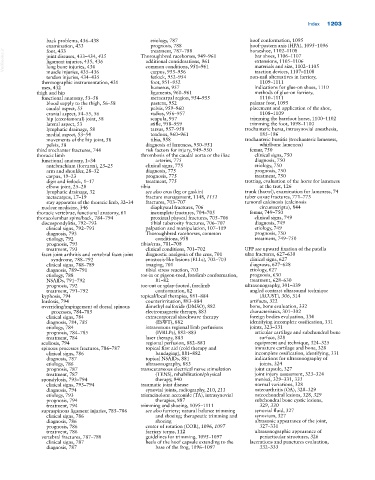Page 1237 - Adams and Stashak's Lameness in Horses, 7th Edition
P. 1237
Index 1203
back problems, 436–438 etiology, 787 hoof conformation, 1095
examination, 433 prognosis, 788 hoof‐pastern axis (HPA), 1095–1096
treatment, 787–788
horseshoe, 1102–1108
foot, 433
VetBooks.ir joint diseases, 433–434, 435 Thoroughbred racehorses, 949–961 bar shoes, 1106–1107
extensions, 1105–1106
additional considerations, 961
ligament injuries, 435, 436
materials and size, 1102–1105
common conditions, 951–961
long bone injuries, 434
traction devices, 1107–1108
muscle injuries, 435–436
tendon injuries, 434–435 carpus, 955–956 non‐nail alternatives in farriery,
fetlock, 952–954
thermographic instrumentation, 431 foot, 951–952 1109–1111
uses, 432 humerus, 957 indications for glue‐on shoes, 1110
thigh and hip ligaments, 960–961 methods of glue‐on farriery,
functional anatomy, 53–58 metacarpal region, 954–955 1110–1111
blood supply to the thigh, 56–58 pastern, 952 palmar foot, 1095
caudal aspect, 55 pelvis, 959–960 placement and application of the shoe,
cranial aspect, 54–55, 56 radius, 956–957 1108–1109
hip (coxofemoral) joint, 58 scapula, 957 trimming the barefoot horse, 1100–1102
lateral aspect, 53 stifle, 958–959 trimming the foot, 1098–1100
lymphatic drainage, 58 tarsus, 957–958 trochanteric bursa, intrasynovial anesthesia,
medial aspect, 53–54 tendons, 960–961 185–186
movements of the hip joint, 58 tibia, 958 trochanteric bursitis (trochanteric lameness,
pelvis, 58 diagnosis of lameness, 950–951 whirlbone lameness)
third trochanter fractures, 744 risk factors for injury, 949–950 femur, 750
thoracic limb thrombosis of the caudal aorta or the iliac clinical signs, 750
functional anatomy, 1–34 arteries, 775 diagnosis, 750
antebrachium (forearm), 23–25 clinical signs, 775 etiology, 750
arm and shoulder, 28–32 diagnosis, 775 prognosis, 750
carpus, 19–23 prognosis, 775 treatment, 750
digit and fetlock, 1–17 treatment, 775 trotting, evaluation of the horse for lameness
elbow joint, 25–28 tibia at the trot, 126
lymphatic drainage, 32 see also crus (leg or gaskin) trunk (barrel), examination for lameness, 74
metacarpus, 17–19 fracture management, 1148, 1151 tuber coxae fractures, 771–773
stay apparatus of the thoracic limb, 32–34 fractures, 703–707 tumoral calcinosis (calcinosis
nuclear medicine, 346 diaphyseal fractures, 706 circumscripta), 844
thoracic vertebrae, functional anatomy, 61 incomplete fractures, 704–705 femur, 749–750
thoracolumbar spine/back, 784–794 proximal physeal fractures, 705–706 clinical signs, 749
discospondylitis, 792–793 tibial tuberosity fractures, 706–707 diagnosis, 749
clinical signs, 792–793 palpation and manipulation, 107–109 etiology, 749
diagnosis, 793 Thoroughbred racehorses, common prognosis, 750
etiology, 792 conditions, 958 treatment, 749–750
prognosis, 793 tibia/crus, 701–708
treatment, 793 clinical conditions, 701–702 UFP see upward fixation of the patella
facet joint arthritis and vertebral facet joint diagnostic analgesia of the crus, 701 ulna fractures, 627–630
syndrome, 788–792 enostosis‐like lesions (ELLs), 702–703 clinical signs, 627
clinical signs, 788–789 imaging, 701 diagnosis, 627–628
diagnosis, 789–791 tibial stress reaction, 703 etiology, 627
etiology, 788 toe‐in or pigeon‐toed, forelimb conformation, prognosis, 630
NSAIDs, 791–792 81–82 treatment, 628–630
prognosis, 792 toe‐out or splay‐footed, forelimb ultrasonography, 301–339
treatment, 791–792 conformation, 82 angled contrast ultrasound technique
kyphosis, 794 topical/local therapies, 881–884 (ACUST), 306, 314
lordosis, 794 counterirritation, 883–884 artifacts, 322
overriding/impingement of dorsal spinous dimethyl sulfoxide (DMSO), 882 bone, bone evaluation, 332
processes, 784–785 electromagnetic therapy, 883 characteristics, 301–302
clinical signs, 784 extracorporeal shockwave therapy foreign bodies evaluation, 334
diagnosis, 784, 785 (ESWT), 882 identifying incomplete ossification, 331
etiology, 784 intravenous regional limb perfusions joints, 323–331
prognosis, 784–785 (IVRLPs), 882–883 articular cartilage and subchondral bone
treatment, 784 laser therapy, 883 surface, 328
scoliosis, 794 regional perfusion, 882–883 equipment and technique, 324–325
spinous processes fractures, 786–787 topical first aid (cold therapy and immature cartilage and bone, 328
clinical signs, 786 bandaging), 881–882 incomplete ossification, identifying, 331
diagnosis, 787 topical NSAIDs, 881 indications for ultrasonography of
etiology, 786 ultrasonography, 883 joints, 324
prognosis, 787 transcutaneous electrical nerve stimulation joint capsule, 327
treatment, 787 (TENS), rehabilitation/physical joint injury assessment, 323–324
spondylosis, 793–794 therapy, 940 menisci, 329–331, 331
clinical signs, 793–794 traumatic joint disease normal variations, 328
diagnosis, 794 synovial joints, radiography, 210, 211 osteoarthritis (OA), 328–329
etiology, 793 triamcinolone acetonide (TA), intrasynovial osteochondral lesions, 328, 329
prognosis, 794 therapies, 887 subchondral bone cystic lesions,
treatment, 794 trimming and shoeing, 1095–1111 329, 330
supraspinous ligament injuries, 785–786 see also farriery; natural balance trimming synovial fluid, 327
clinical signs, 786 and shoeing; therapeutic trimming and synovium, 327
diagnosis, 786 shoeing ultrasonic appearance of the joint,
prognosis, 786 center of rotation (COR), 1096, 1097 327–331
treatment, 786 farriery terms, 112 ultrasonographic appearance of
vertebral fractures, 787–788 guidelines for trimming, 1095–1097 periarticular structures, 326
clinical signs, 787 heels of the hoof capsule extending to the lacerations and punctures evaluation,
diagnosis, 787 base of the frog, 1096–1097 332–333

